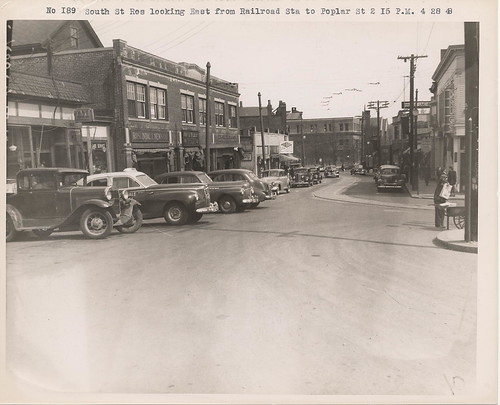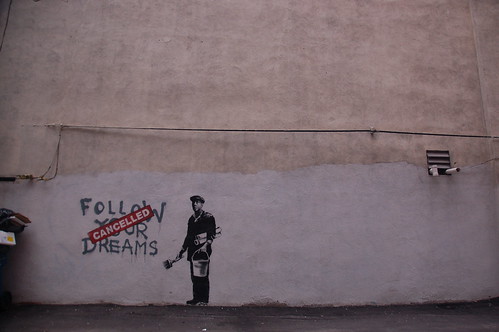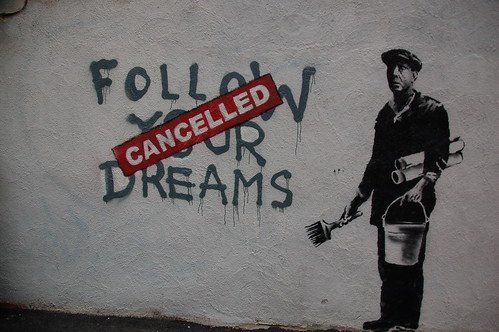Downtown (Square-Village-Center) Roslindale, MA 1948 from Roslindale Historical Society ‘OR’ City of Boston.
Downtown (Square-Village-Center) Roslindale, MA 1948 from Roslindale Historical Society ‘OR’ City of Boston.

Image by clamshack
Roslindale Historical Society
The story of our community, Roslindale, necessarily begins with the arrival of the first settlers in the area. Rather than settling in what is now Boston, some of the early settlers journeyed across the narrow piece of land known as Boston Neck, and made their homes there. What was then the town of Roxbury, settled on September 28, 1630, only three weeks after the official date of the settlement of Boston; it was about two miles wide and eight miles long, running from Boston to Dedham. The region abounded in rocks, and thus became known as Roxbury, originally spelled “Rocksbury.” The western part of Roxbury was known as Jamaica End or West Roxbury, and our community of Roslindale was part of this area. It was not until the establishment of a post office on March 15, 1870, that this community became known as Roslindale.
It is interesting to find the geological reasons, which influenced the history of this area. Going back 500,000,000 years, we find this region under the sea, with a volcano spouting lava at a spot near the present junction of Washington and Grove Streets. The famous Roxbury “puddingstone” was a result of this volcano and the action of the sea. With the ice age, a great sheet of ice, as the climate became warmer, created drumlins, of which Bellevue Hill is one. The water, which was trapped, formed kettle holes. Two of these kettle holes are Jamaica Pond and Muddy Pond. The Charles River, which formed the boundary of old Roxbury, formed its winding course around the glacial deposits. These windings were what made the narrow Boston Neck, which set Roxbury off from Boston. This neck was all but covered with water at high tide, in the early days of Roxbury and Boston.
As Roxbury grew, the early settlers moved out along the main path from Boston to Dedham, the Old Dedham Post Road, now Centre Street. Although there were few Indians left in the area, due to a smallpox epidemic, it is certain that this early road had once been an Indian trail. The Indians usually traveled along rivers and ponds, and would quite likely pass by Jamaica Pond and along the banks of the Stony River. Stony River began on the slopes of Bellevue Hill and in Muddy Pond woods, and went through what is now Roslindale Square. Until it was forced underground, it was an important river. The early settlers ignored the law against settling more than one half mile from the church, as well as taking chances with the wolves and bears which were plentiful in the heavily wooded areas.
As early as 1626, Miantonimo, King of the Narragansetts, traveled over the Dedham Road with his wife and attendants. King John of the Nipmucks brought Matoonis, another chief, to be put to death on Boston Common for his part in King Philip’s War. John Eliot used this road on his way to preach to the Indians. Ann Hutchinson probably traveled over it on her way to Rhode Island to seek religious freedom. With the outbreak of the Revolutionary War, the Dedham Post Road carried Minute and Militia to Bunker Hill, among them Nathan Hale and Benedict Arnold. George Washington made four trips over this road, one of which was to take command of the Continental Army in Cambridge.
A famous spot on the Dedham Post Road, near the corner of what is now Allandale and the Centre Streets, was the Peacock Tavern. This tavern was kept by Captain Child, who was a captain of one of three Minute Men companies from Roxbury who answered the call to arms on April 19, 1775, and fought the British at Lexington and Concord. Before the Revolutionary War, the Peacock Tavern was favorite gathering place for British officers, who headed there after holding skating parties on Jamaica Pond. During the siege of Boston, George Washington inspected his battle lines, which included Weld Hill in what is now the Arnold Arboretum. Washington had picked Weld Hill as a rendezvous in case the British succeeded in driving the Continental army back and in capturing the stores of ammunition located in Dedham. After his inspection in the area, Washington would partake of refreshment at the Peacock Tavern.
Opposite the Peacock Tavern, there stood, and still stands today, a stone milepost, which says: “6 mi. from Boston 1753 P.D.” These initials stand for Paul Dudley who erected the stone, as well as others on the road leading from Boston.
Another important road for Roslindale was Washington Street, called the Dedham Turnpike, which ran all the way from Boston through Roslindale Square to Pawtucket, Rhode Island. It was opened for traffic in 1805 as a toll road, and was the principal stagecoach route. Taft’s Tavern, situated at the corner of Mayo’s farm on the Dedham Turnpike, was famous for its game dinners and hearty brew. It made Roslindale a major stopping place on long trips. The Tavern later became the Union Inn until the top part of it was destroyed by fire. Eventually it housed the school, and finally the Roslindale Brach Library in 1900. In 1919 it was torn down, and in its place is the Irving W. Adams Park in Roslindale Square.
From the Revolutionary War to the last part of the 19th century, West Roxbury, of which Roslindale was a part, was primarily a rural community, consisting of large farms supplying agricultural goods to the city of Boston. There was virtually no industry. On the west side of Church Street, between Centre and South Streets, was the Weld Farm, owned by Captain Joseph Weld, and “The story of the naming of Roslindale is a very interesting one.” My father, who was a newsdealer, passed it down to me. It was down to him from the man who was reputed to have named it. It seems that in the early 1800’s, Roslindale was part of Old Roxbury. Roxbury extended from what is now Roxbury Crossing out to the Dedham Line. We had West Roxbury, which was the West part of Roxbury, then we had Roxbury, but the land in between didn’t have a name except for that of “South Street Crossing.” It was called this because the railroad crossed South Street at the street level.
The people in the community wanted to apply for a post office. The name “South Street Crossing” wasn’t acceptable to the government. So all the landowners got together to give the area a definite name, a name of distinction. There were perhaps a half a dozen big landowners that owned a great section of the community. They had a meeting, and each landowner suggested a name.
“When it came John Pierce’s turn, he, an Englishman by birth and a person who had traveled extensively, told the assembled citizens that the so-called “South Street Crossing” and its vicinity reminded him of a certain historical town he had visited in Scotland. Mr. Pierce said that the rich and romantic landscape of this section composed of so fine a variety of hills and dales, stately trees and profuse shrubbery recalled in the mind of the beautiful little historic town of Roslyn in Scotland, outside of Edinburgh. Pierce also said that this area was like a dale because of all the hills surrounding the area. So he thought that a combination of “Roslin” and “dale” would be an appropriate name. That was the name that was submitted to the Post Office Department and the name that was subsequently adopted.”
The founding of the meetinghouse on Peter’s Hill in 1712 led to this area being developed as a rural community with large farms. It was not until 170 years later that an incident occurred which brought the Roslindale area out of the farming era, and into the 20th century suburban development. This incident was the famous “Bussey Bridge Disaster.” Mr. Richard Davis has researched this disaster, and wrote this account of the famous train wreck:
“What was described at the time was first major railroad disaster in America and brought Roslindale nationwide attention occurred on March 14, 1887, when the bridge spanning South and Bussey Streets collapsed when a train bound for Boston hurled nine passengers cars over a granite abutment into a 75-foot opening caused by the collapse of the bridge. Of the 23 killed and 115 injured, 50 percent were Roslindale commuters on the way to work in Boston.”
Considered extremely modern, the bridge was constructed of iron and steel and had replaced the original Howe truss “Tin Bridge” in 1870. The lawsuits resulting from the accident nearly bankrupted the Boston Providence Railroad. After making tests of wreckage parts at Watertown Arsenal, experts fixed the cause of the collapse on faulty welding in the hangers of the iron truss on the western side of the bridge, which had to support four-fifths of the weight of a passing train.”
“A direct result of the disaster was the removal or rebuilding of hundreds of iron railroad bridges all over America. Until Bussey Bridge taught them a lesson, bridge builders of the day had failed to realize that constant vibration weakens iron structures.”
“The disaster, however, started a new growth in Roslindale. Hundreds were attracted to the scene over a considerable period of time, and they discovered a beautiful community in the country. From then on Roslindale and West Roxbury started to grow in new homes and population, attracting people from all sections of Boston.”
Mr. Davis describes how his own family came to live in Roslindale as a result of the Bussey Bridge Disaster:
“At that time my father and grandfather lived in South Boston. My grandfather was a builder in Boston, who had built part of the Old Boston City Hall. He and my father walked out from South Boston to Roslindale in order to see the disaster. And when they got there, they looked around, and my grandfather said, “Son, this looks like a beautiful country.” He said, “I’d like to live around here. Maybe we ought to move out here.” Subsequently, they came to Roslindale, and he built his home. The wreck brought a great many people.”
While the wreck of the Dedham-Boston commuter train was an immediate impetus for a new wave of Roslindale immigration, the reasons behind the growth of Roslindale are largely increased transportation facilities. During the last quarter of the nineteenth century, the West End Street Railway ran horse-drawn cars via Egleston Square through Jamaica Plain to Forest Hills There, they were met by horse-drawn cars of the Norfolk Suburban Street Railway Company that continued to Roslindale via Hyde Park Ave. Cars ran more frequently on Sundays, as visits to the country were a popular past time. The city of Boston was becoming more and more crowded as European immigrants arrived in increasing numbers. The children and grandchildren of previous immigrants needed space, and appreciated the clean air and gardens of the suburbs. They liked what they saw on Sunday Trolley rides, and began to move out in the direction of public transportation which was growing to meet the demands of the city’s mushrooming population. Boston’s suburbs, including Roslindale, began to grow. In 1896, with a West End Street Railway put its horses and cars up for sale. Electric trolleys began to run from Forest Hills to Dedham in 1896 with a West Roxbury branch through Roslindale via Belgrade Ave and Centre Street. The Boston Elevated Railway, chartered in 1984, last century. They were apparently on target in their advice, as some of the community’s active senior citizens show the healthy influence of Roslindale’s air. Mr. Clarence Wilson moved to Roslindale eighty years ago as a young boy.
“It was eighty years ago that we moved to Roslindale. On May 28, 1894, I, a boy of nine, came with my family from Jamaica Plain to live on Birch Street where I still reside. It was a beautiful day (although two weeks of rain followed), and the native charm of the vicinity with its fields of tall grass and fruit trees was marred only by the lingering odor of burnt horseflesh. A large stable (then situated on Corinth Street between Birch and Cohasset Streets) had burned a few days before the arrival of my family. About 12 horses had perished in the blaze and their remains were just being removed.”
“It had been on the recommendation of a Dr. Stevens who resided on South Street that the family immigrated to Roslindale. Frank Wilson, my older brother, was suffering from tuberculosis and the salutary climate living conditions here were sought by the family for the recuperative effect they might have on his health. At that time, no doctor knew very much about this disease. Mr. Stevens, whose house still stands on South Street opposite the playground, suggested that the best solution he could think of was to live either in Sharon or Roslindale because of their healthy situations. My father and mother chose Roslindale.”
By the turn of the century, many families were moving to Roslindale for various reasons, mainly as part of a general movement out of the city’s core as Boston’s population overflowed into the suburbs. Real estate dealers capitalized on this phenomenon, and Roslindale began to be called a “garden suburb” of Boston. Roslindale was no longer the country. Mr. Dick Davis says of this change in the Roslindale area:
“I’ve seen it grow to be one of the best residential areas in the city. And, they gave it the name “The Suburb Superb.” That name was coined by the Roslindale Board of Trade. And it really was a superb community. It was a community of homes and a minimum of manufacturing, and it became known as the bedroom of Boston.”
The people who were moving into the new suburb of Roslindale were different from the earlier settlers. As a country area, Roslindale had been largely old-time Yankee, and Protestant. The new residents were, for the most part, Boston-born sons and daughters of immigrants, and predominately Catholic. The original Yankee village of Roslindale has become over the course of its development an unusually well mixed community, first the Irish, then with the Italians and other European groups, and later with Eastern Mediterranean and Arabic nationalities. Surprisingly enough, few problems have resulted from this ethnic mix. This community has been characterized by acceptance of new groups and a joy in cultural diversity and sharing in the community for the past 40 or more years, was in the hospital. He saw a notice in the paper that all unclaimed bank deposits were going to be turned over to the state, which is apparently customary procedure. He noticed that the name of the Old Roslindale Memorial Association was there. So when he got out of the hospital, he got in touch with me. We found out that the money would revert to the state, so we wanted to reactivate it. We had to go to court. At first the judge said, “Well, give the money back.” We didn’t know who it was collected from and how much they gave. So finally, through our efforts at the State House, the legislature made it possible for us to erect a monument with the amount of money we had. Of course, Fred Davis, being a monument dealer wouldn’t have anything to do with it. But we did hire a man who designed a monument which we approved.”
Another World War I veteran returned home a champion runner. Mr. Fred Faller, a retired watchmaker who lived in Roslindale for over 50 years, tells his story as a long-distance runner:
“I went to West Roxbury High School, which was in Jamaica Plain, and did a little running in high school. After high school, I ran the Allandale course, which all the young men in our area knew. It ran about 3 and 4/10 miles. We had a neighborhood boys club called the Oakland Athletic Club. We built a hut at the corner of knoll and Selwyn Streets. After running this course in record local time for one lap, I got ambitious, and continued so I was able to do 2 laps in good time. On April 19, 1912, I ran in my first 10 miles with a fairly liberal handicap, which was under the A.A.U. competition. Given the fact that a few of the good men were in the Marathon that day, I won the race. I gradually improved so that in 1917 I was first in New England. In April 1918, I was drafted. After arriving in Paris, I found they were selecting an American team to compete in the inter-Allied games.”
The young Roslindale soldier saw opportunity knocking, and became a championship runner in the European Allied games, returning home to win New England 5 mile championship, the New England 10 mile championship, the New England cross-country championship, the National cross-country championship, and the National 10 mile championship. In this race, he broke the American record by an American citizen, and this record was held for 40 years, until 1959. He was picked as All-American in the National 10 mile and National cross-country races by the A.A.U. He went to Philadelphia to try out for the U.S. Olympic team and finished third for that day. In 1920, the final U.S. Olympic tryouts were held at Harvard Stadium. Here he won the 10,000 meter race and qualified as first choice for the 10,000 meter Olympic race and the 10,000 meter cross-country race at Antwerp, Belgium. He was the only man out of four from the United States who tried out for the 10,000 meter at Antwerp who qualified for the finals representing the United States. He finished ninth in the 10,000-meter race and 14th in the cross-country race at the Olympic games. Coming home, he won the National cross-country and National 10 miles again. He was the first man to ever win the A.A.U. cross-country and the National 10 mile for two consecutive years.
“The number of boys who went on these expeditions to the woods grew, and the use of the little “Gramp” grew as well. Out in the hills, a camp was built to which many of the boys of Roslindale who have grown up and moved away helped to wear a trail. They grew up and other boys took their places and soon “Gramp” was not only used as a personal salutation and in conversation, but as the years went by, Uncle Sam’s mailmen were delivering letters from all parts of the country which bore the simple legend on the outside: “Gramp, Roslindale, Mass.”
“A character who lived in the Roslindale woods intrigues these same boys, inspiring romantic conjecture: “There is the story of the Hermit of Grew’s woods. Grew’s woods was a section of Roslindale bordering Hyde Park. It’s almost an extension of Beech Street. There was a hermit who lived in an old hut that he had built. He lived by trapping animals and selling the fur to people. He lived by himself, and he became known as the Hermit of Grew’s woods. Some people said he had a love and he was disappointed. By birth, he was an Englishman. I don’t know whether the love affair took place in England or in the United States. He would entertain you if you went up to see him.”
During the 1930’s, the new Parkway Transcript published reminiscence about some of Roslindale’s citizens – people who implanted themselves in the community’s collective memory. Blacksmith shops seemed to have served as the “smoke-filled rooms” of a previous era.
“Parker Weeks’ blacksmith shop was the actual quarters for most of the politicians of the upper section of Ward 23, regardless of party in days gone by. Many a deal was hashed out and cut and dried under the music of the old blacksmith’s hammer. I fear if Parker had a mind to open up, he could furnish a few memories for the boys or a revised edition of the Arabian Nights.”
Characters of every occupation give a flavor of early Roslindale:
“An old Indian doctor held forth nightly for a week or more every summer in Roslindale Square. He occupied a raised platform and usually opened his nightly program with a story or two followed a general diagnosis of all sorts of diseases and a lengthy dissertation on his “cureall” which guaranteed would cure anything from toothache to smallpox. Large numbers came out nightly to see and hear the fun, but few sales were made.”
“A man named Levine once had a soap factory on Hyde Park Ave just before reaching Canterbury Street on the right for a long term of years. Years ago, he sold out the premises to a family named Mauser who remodeled the buildings and moved out to Westwood.”
The words of Roslindale people give a vivid visual picture of the way it used to be:
“On Poplar Street, where the park is now, was a block of stores owned by my mothers cousin Charles West. It was about 1919 that these buildings and the old wooden building which housed the public library were moved to make room for the park.
“The Roslindale that my father came to was very much a rural area. There were several small farms in the area. Around where the Charles Summer School now exists was a farm. It had cows and sold milk to the local residents. You came down, brought a container with you, they filled it with milk and you took it home. There was another farm on Dudley Ave (now Durnell Ave), and the Hayes Road area was at the that time all pastureland.”
“We used the livery stables and things like that when we had horses and carriages and horses and wagons. Of course, they tore down Morrison’s Livery Stable on the corner of Birch, and the Rands kept their horses over there. Then came the automobile. Of course, that meant horse stables went out of business, torn down, and stores were built in there.”
The financial and social center of Roslindale was called the “Village “ and until after World War II had the flavor of a small town meeting place.
“Well, there wasn’t much in the village. There were no stores on Corinth Street, and there were a few on Poplar Street and Washington Street. There was Rand’s Corner, and then there was the library where the Rialto Theatre is now, but that was moved, that was only a wooden structure. And there was also a movie place where we watched silent movies.”
“In the early forties, the village was the only place to go shopping unless you went in town because there were no shopping centers. Everyone was walking-the women didn’t drive. You’d see baby carriages all pushed together. The women were always down there.
“It was a town of people. You know, whereby you could go down the street and talk to other people…it was a friendly town, anyway, and everybody went about their business, and there were not many conflicts.”
In 1706, there were about 45 families living in the territory west of Jamaica Pond. In that year, Joseph Weld and 44 others filed a petition asking to form a separate Church and parish. They stated that they lived in the west end of Roxbury toward Dedham; that it was difficult for them to attend church at the First Church in Roxbury in bad winter weather; and that even in good weather, it takes a great deal of their time coming and going. They would like to be freed from taxes in connection with the old church, and ask for assistance in building a new one. This petition was largely ignored by the First Church, which quite naturally did not like to lose the income from these parishioners. So the ingenious settlers went ahead and built a church anyway. The church was built on land donated by Joseph Weld, and stood on Peter’s Hill, on what is now Walter Street, near Mendum Street, next to what is now the Arnold Arboretum.
After the church was built, again the settlers petitioned, begging the humble pardon of their brothers for what they had done. This request was of course granted, and the west end of Roxbury was made a separate percipient. The second Church of Roxbury was gathered on November 2, 1712, and its first pastor was Ebenezer Thayer.
Next to the church was the “Burying ground”, which still exists today, as the only sign of this early church. The first meetinghouse served a whole generation. When it became too dilapidated, a new church was built at the corner of Church and Centre Streets. Some of the timbers from the original church were used in this building.
Thus it was here in the little church on Walter Street that the community, which is now Roslindale, had its beginnings. Here in the meetinghouse, the people gathered to worship on Sundays, and on weekdays, to regulate the affairs of the town. From gatherings such as these came the principals on which our nation was based.
Roads played a great part in the development of all the early communities. The main road, which now passes through Roslindale, is Washington Street, but this road, called the Dedham Turnpike, was not built until 1804. Before that date, the main path or road from Boston to Dedham was what we now call Centre Street. This road was called by many names, including the Dedham Post Road, and was not given the name Centre Street until 1825. The old road traveled up the present Centre Street from Jamaica Plain, and turned left after passing Allandale Street, over what is now called Walter Street, and up South Street to the present junction of Church and Centre Streets, and then on to Dedham via Centre and East Streets. The Dedham Road not only connected the east and west portions of Roxbury, but connected Boston with providence and points west and south.
It was not until 1870 that Roslindale, until then a section of West Roxbury, known as “South Street District”, and then “South Street Crossing”, became a postal district and chose a name for itself.
Despite, or because of, the ambiguity of Roslindale’s identity, its citizens have developed a special pride in their community, which expresses itself in several legends explaining the naming of the community. Mr. Parker Weeks, a fondly remembered Washington Street blacksmith, claimed that the area was named after the Scotsman’s home:
“Roslindale was originally, of course, a part of the town of West Roxbury, but this particular section was known as “South Street Crossing.” Later a Scotchman names Laurie, from Roslyn, Scotland, build a house, now standing on Florence Street, which was known as the Freemantle house. He built an arch over his gate, and called it Roslyn Cottage.” He was very active in all town affairs and from “South Street Crossing”, the place came to be known as Roslyn, and later the name was changed to Roslindale.”
Another story holds the name to be a derivative of “Roseland”, because of the rose gardens characteristic of its fertile land. The most popular version of the naming of Roslindale connects Roslindale with Roslyn, a town in Scotland. Mr. Dick Davis, a longtime Roslindale resident, and for many years editor of the area newspaper, The Parkway Transcript, tells of the legend this way:
“Roslindale is unique from other parts of Boston. It has a uniqueness I don’t think you could match any place in the world, because it is the only town, it is the only community by the name of Roslindale in the world. I have never heard of another Roslindale. We have Dedham, Mass., and Dedham, England; Dorchester England; Newton, England. Most of the towns in early America were named after their counterparts in England. But Roslindale was a unique name. It is a coined name, a manufactured one.”
“In 1887, people had to be at work at an earlier time than at the present, and since there were no car lines, they bought five-strip tickets for 35 cents to commute from local suburbs on the Boston and Providence Railroad.”
“On the pleasant morning of March 14, the fatal train made up at Dedham at 7am had collected over 300 passengers bound for work in Boston, and had made five stops by the time it had reached Roslindale. At 7:20am, only a few moments after Roslindale passengers boarded the train, all nine cars were hurled over a granite abutment into the 75 foot chasm opened by the collapse of the bridge.”
“When the catastrophe occurred, engineer Walter E. White had the throttle at an estimated 30-mile an hour speed, approaching the bridge in a down grade stretch three fifths of a mile long, that ended in a slight curve.”
“The strain that caused the collapse of the bridge was later found to have been brought about by the weight of the passing engine, which left in its wake a slight depression that increased to the breaking point when the first car hit the bridge. After the first car jumped the track to the east, the second followed, dropping still farther. The following seven cars telescoped against the second, and were forced down with them over the abutment into the street in a tangled mass of wreckage. The majority of fatalities occurred in the fourth, fifth, sixth, and ninth cars, several of which plunged end over end into the street below to land almost upright. Cries of the injured and dying filled the air. The engine which had cleared the bridge, continued on to Forest Hills blowing its whistle constantly to attract attention while the engineer leaned out the cab window, pointing back so people would know that something happened. When the engine reached Forest Hills, police were notified to send doctors and ambulances to the scene. Meanwhile, Roslindale doctors were notified and sped to the scene by hoarse and buggy. Neighbors meantime opened their homes to the injured. Large crowds gathered and assisted in removing the injured and dying from the debris. It was by magic that a fire hadn’t occurred, for the cars had wood burning stoves to keep the cars warm. It being a mild morning, the stoves were not in use. Had it been a cold morning and the stoves burning, most of the passengers would have been trapped in the inferno. Horse-drawn ambulances and private carriages supplied by neighbors conveyed the injured to the hospital and homes. Doctors from Boston were dispatched to the scene of the wreck.
“The ill-fated bridge near the Arnold Arboretum was named after Benjamin Bussey, whose estate the Boston and Providence railroad bisected when laying the roadway. When the bridge was built, the railroad tried to change the location of the road so that South Street would pass under the bridge at right angles, instead of diagonally, thus shortening the span and dividing the stress and strain. This proposal was opposed by Harvard College, to whom Benjamin Bussey had willed his estate, because it would have meant the removal of a number of elm trees along the way.
Mr. Philip Pofcher, a Roslindale Lawyer, who, though blinded by an automobile accident as a teenager, became not only a member of the Bar, but a broker and a public accountant as well, tells how a trolley brought his family to Roslindale:
“My family history in Roslindale starts just after the turn of the century. At that time, my father had a clothing store in the West End, and was looking to move to a suburban area. He considered that custom tailoring and repairing with alteration had more of a future for him in the suburbs than would a clothing store in town. He took the Boston Elevated and engaged the conductor for suggestions and information about communities he was going through. The conductor became unhappy with all these inquiries. He told my father that he was there as a conductor, not as an information service. At that point, my father told the conductor what he could do with his streetcar, and got off. He got off in Roslindale Square. He looked around and found that there was only one tailor shop, owned by someone named Noonan. After a casual inspection, it became apparent to my father that Mr. Noonan could stand some competition.
“My father went to a man by the name of Porter, who owned a block of stores up against the railroad station on South Street. He asked Porter if he would rent him a vacant store. Porter was very anxious to rent the store to my father or to anyone else. He offered my father a free months rent. My father refused the free months rent, and told Porter that if he took the place without paying rent he wouldn’t be working hard enough. Instead, he induced Porter to reduce the rent for all the months. As my father stayed on for some time, it turned out to be a very good proposition for him.
“A few years later, about 1905, a man by the name of W.P. Whittemore, an old-time Roslindale man, built the block from 749-755 South Street. That was across the street at that time from Flood and McKay’s Market. Having built the block of stores, he went to see my father and asked him if he would care to buy the block. My father told Mr. Whittemore that he had no money. Whittemore offered to sell it to my father with practically no money down. Mr. Whittemore took back a mortgage for the rest of it. My father then moved into 755 South Street with his tailor shop. He had his tailor shop here for almost the turn of the century until he died in 1954. He was in business in Roslindale for just under 50 years.
Ease of transportation was not the only reason for increased immigration to Roslindale. Some new residents came on the prescription of doctors who recommended the “salubrious climate” of the area, particularly for the lung diseases that are prevalent.
Roslindale residents are proud of the harmony of their community and are especially proud of the achievements of certain of its citizens. Roslindale has its heroes, among them the veterans of America’s Wars. The soldiers coming back from World War I returned to elaborate “Roslindale Welcome Home Day” with athletic games and parades. Armistice Day itself was celebrated with religious observance. Father Cummins, first pastor of Sacred Heart Church, recalled the day 12 years later:
“Who can forget that memorable day? A military mass was celebrated in this church a few hours after the joyful news of the armistice reached this city. The Spanish War Veterans of Boston, those gallant survivors of the old Ninth Massachusetts Regiment, with whom I wore the khaki in 1898, and veterans of the Indian Wars rallied here in goodly numbers form all parts of the city, and sponsored the first Armistice Day Mass. Let the traditions of this day be inseparably entwined in your hearts, moving them to a manly pathos and firming them with patriotic ardor.”
One of the soldiers who did not return for Homecoming Day was Irving Adams. Mr. Frederick Mellin remembers him:
“Irving W. Adams was the first Massachusetts boy killed in World War I. He lived up on the corner of Edgemont Street and South Street. He went to the Longfellow School; he was ahead of me in school. Then I think he moved to Mechanics Art School, which is now Boston Technical High. He was the first Massachusetts boy killed in World War I, killed on the battlefield. They named the post up there for him.”
Roslindale citizens not only named an American Legion Post after Irving Adams, but also decided to his memory the center of their community, Irving W. Adams Park in Roslindale Square. Mr. Davis tells the story of how the monument came to be in the Center of Roslindale Square.
“After World War I, the people of Roslindale, including members of the different clubs and veterans organizations wanted to erect something in memory of the soldiers who had served in this war. They appointed a man to make a design for a statue to be erected in what is now Irving W. Adams Park. The price was to be ,000, so that was the goal set. They had a miniature model made of the proposed monument, and it was on display in a store window on South Street called Water’s Candy and Ice Cream Parlor. They made a house-to-House canvas and the people contributed. They were never able to raise ,000 that was needed, so the money lay dormant in the bank. They couldn’t erect another monument of lesser cost because they had received permission from the Secretary of State of Massachusetts to raise the money for this monument. So the money remained in the bank until about 20 years ago, about 1950.
Over the years, Roslindale residents have gathered memories of how life was lived in the beginning of this century when Roslindale was but a country village.
On winter and coasting”
“I remember as a very young boy before the plows came, they had a great big roller. Instead of plowing the road, why they just rolled it down. This was for the runners of the sleigh to enable it to run faster. IT packed the snow down and it was also great for coasting.
“At that time we could start up near what is now the West Roxbury Parkway, up by Bellevue Hill. Incidentally, in those days, the hill was much steeper. They took the grade off because it was very difficult for the cars, the automobiles and the streetcar, to go up the hill. If they stopped in the middle and it was icy, they couldn’t get going. So they did cut the hill down. So we could start there and on a good day, we could go right down to what we used to call the Washington Street Playground, now called Healy Field. Although we could start at the top of Metropolitan Avenue to Kittredge Street, and you go right down the line to Roslindale Square, until they threw ashes and cinders across the street so we couldn’t go shooting through the traffic.”
On the Fourth of July:
“Of course, I was always a part of the Fourth of July as long back as I can remember. At that time, the 17th of June, Bunker Hill Day, was a very appropriate day, because there was no school, and also the Fourth of July. My father sold fireworks for forty odd years, until they were banned. He didn’t sell them in his own store, but he used to have a little store on what is now Robert Street under the railroad bridge, and every year we sold fireworks. On the night before the fourth, we used to have a fireworks display at what is now Fallon Field, and sometimes they would have them down at Healy Field. Father Cummins had his great barbeque, and people would come from all over Boston. They’d have a great big ox that’s on a spit. They’d have a fire on the grounds, and they’d turn the spit over and roast the ox right on the playground, and then at night, why about 6 or 7 o’clock at night, why they’d stop and cut it up and they’d sell sandwiches. And in the meantime they’d be taking chances on wheels and pinwheels and everything. And they’d have different kinds of amusements and Ferris Wheels, and they really rolled out the carpet.”
Certain people, certain characters of Roslindale stand out in memories and lend legendary vivacity to her past. Older citizens remember people important to their youth. “Gramp” Hodgkins was a naturalist who introduced boys of the early 20th century to the secrets of nearby woods.
Present-day Roslindale memories focus on a number of colorful people; some of these are tradesmen, etc.: “One of the merchants was F.D. Rand. This store was at the corner of Corinth and Washington Streets. They were there for years and years. They used to deliver their groceries with a horse and wagon. Their wagons were familiar all over Roslindale. They were the S.S. Pierce of Roslindale, and they did a good business. Their slogan was: Prudent families buy at Rands.”
“Every Saturday, the father, Harold Rand, would go out in a nice buggy and go around collecting bills from people who owed him money. You wouldn’t have to go to the store, he’d go to see you and collect. He had a regular route every Saturday. Of course, in those days for ten dollars you could buy enough to last you pretty near a month!”
“The ragman, Liebowitz, came around on the old horse drawn wagon. He had the saddest Clothes. For many years he would come by and he would always cry “RAAAAAGS! RAAAAAGS!” Then one day there was a rival Wagoner, he used the same word—RAGS—but he didn’t have the same song!”
“The Pony Express was a favorite of all the kids in the forties. A teenager selling ice cream rode on a two-wheeled cart pulled by a pony that had a pom-pom on and bells around its neck.
The community of Roslindale, names for its lovely hills and dales, has felt the squeeze of urban living. Open space is disappearing as the population becomes more crowded. However, Roslindale is a mature community with an awakening consciousness of its identity. Recognizing the problems and challenge of urbanization, Roslindale maintains the friendliness and spirit of a “garden suburb.” The people of Roslindale live their community. There is a feeling of kinship for one another in the air, and they show a great deal of concern for their town. It is theses attitudes, this spirit that has made Roslindale what it is.
ROSLINDALE – SUBURB SUPERB
First Printing: 1974, Second Printing: 1994
David P. Kunze
Judith C. Kunze
** Photo taken in 1948/1949. From a collection of photos by the Boston Traffic and Parking Department.
Posted under this Creative Commons license.
Contact Us
Copyright © 2014
Maria Ventresca Bennett
All Rights Reserved
Home | Memories | Facebook | Photos | Roslindale Today | Links | Twitter
Contact us: P.O. Box 356, Roslindale, MA 02131 or 617-323-5710






